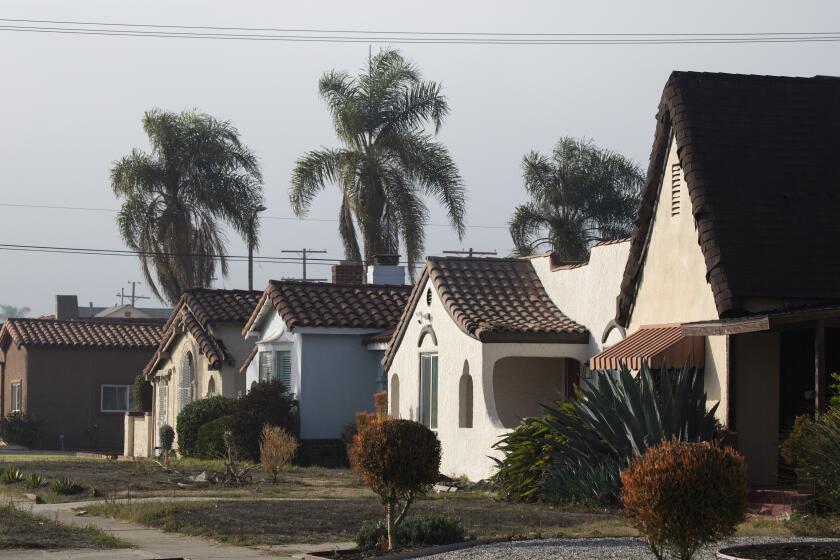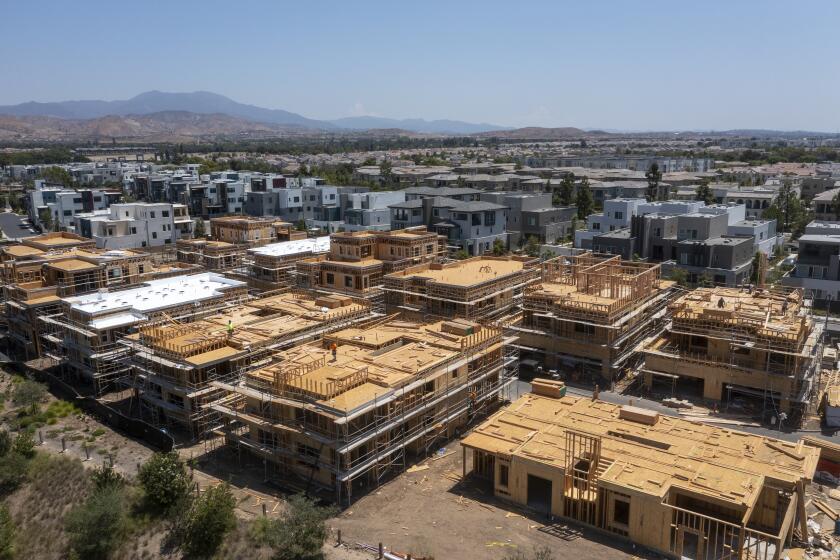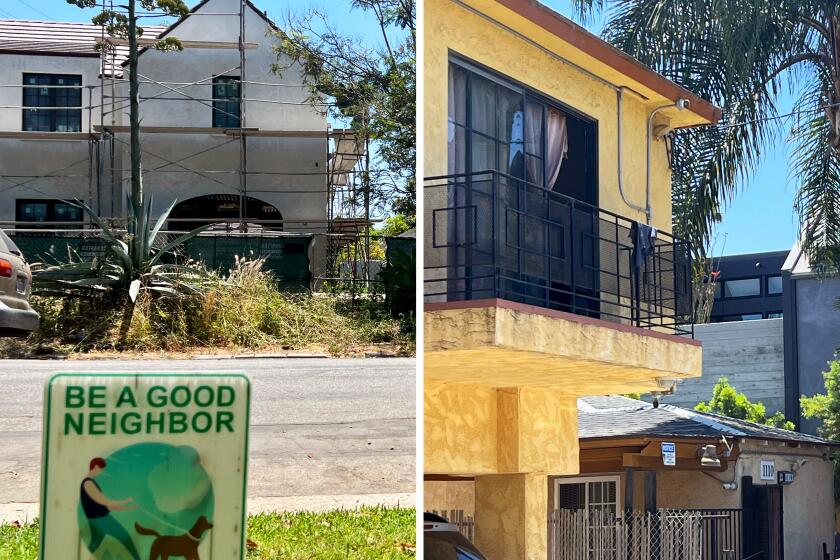Can’t afford a house in L.A.? Here’s how that happened

- Share via
The high cost of housing is driving Southern California’s biggest challenges. Income is not keeping pace with housing costs. It hasn’t for at least two generations, and the problem of unaffordable shelter shows few signs of letting up.
There’s a metric called “housing burden” that lays the situation bare. Over the last 50 years, it tracks the growing, gaping mismatch between income and shelter costs in Los Angeles County.
In 1979, UCLA land experts Leo Grebler and Frank Mittelbach wrote: “As a general, time-honored rule of thumb” house prices in a community “should not exceed 2 to 2½ times the annual income” of its residents.
Within a decade, home prices began to drastically violate this rule. If it were applied today, it would mean a four-person household with the median Los Angeles County income of $98,200 could afford to buy a house that cost $245,500. However, the median home price in the county last month, according to Redfin, was $980,000.
How did things get so unbalanced?
In the 1950s and 1960s, buying a single-family home in Los Angeles was an attainable prospect. The GI Bill and the Federal Housing Authority helped with loans and mortgage dollars (albeit primarily for white families). And home building was on a tear, thanks to the region’s pro-development political climate.
By the 1970s, however, a cascade of factors — local to global — changed the equation.
California’s median home price is near $750,000. The most promising prescription for the housing shortage is undoing single-family zoning and increasing density.
Housing prices first shot ahead of income in the mid-1970s. Analysts attributed the spike to the first cohort of baby boomers reaching home-buying age, which expanded the pool of buyers and created a seller’s market. The 1973 oil crisis and ensuing inflation pushed buyers to pay up for fear prices would rise even higher. Unrelenting demand thus not only kept pace with prices, it increased them.
Social-demographic factors also factored in. Per capita income doubled from 1966 to 1977, due in part to more women in the workplace. When federal policies struck down gender discrimination in loan and credit decisions, two-income families could qualify for larger mortgage loans, elevating the demand for higher-priced homes.
We were first-generation Latina home buyers seeking to get our family out of a crowded 450-foot apartment. Here’s how our housing search went.
Then land and building costs climbed, pushing prices even higher. And in 1978, Proposition 13 became law.
The ballot measure slashed property taxes and with them, funding for municipal services. Cities and towns scrambled to recoup the lost revenue. New real estate developments were “money-losers,” as urban planner and former Ventura Mayor William Fulton observed, because property taxes fell so low. Instead, municipalities turned to retail development to generate lucrative sales tax revenue. Prop. 13 thus became a powerful disincentive to build housing.
Thousands of short-term rentals are breaking the law. The city is leaving millions of dollars on the table by not enforcing the rules.
The rising slow-growth movement put another damper on housing supply. It was pushed by homeowners who resisted adding multifamily housing in single-family neighborhoods or new development in nearby open space.
One study by the California Legislative Analyst’s Office found that by the early 2000s, more than two-thirds of cities and counties in coastal California metro areas had slow-growth policies in place, and that when a community added such a policy, it resulted in a 3% to 5% increase in home prices. Moreover, the historical momentum of R-1 (single family) zoning stymied the construction of multifamily units.
The upshot of all these pressures? From 1980 to 2010 in Los Angeles, the population grew by 31.3% while housing units grew by only 20.6%.
California is losing population and adding housing units, but housing costs are still sky-high, and experts don’t expect that to change anytime soon.
L.A.’s spiraling housing costs paralleled trends in large, global metro regions by the turn of the 21st century, suggesting that forces beyond L.A. were also at work. In the 1990s and early 2000s, the housing bubble was driven by finance structures linked to global markets, inflows of global capital and unregulated banking practices that set off unrestrained and predatory lending and buying frenzies. Even after the 2007-09 banking crisis and Great Recession, home prices in L.A. soon regained traction.
Taking a longer view, economist Robert Shiller traced rising housing costs in the late 1980s and early 2000s across metro areas globally, including L.A. He pinned a good deal of the blame on “irrational exuberance” that motivated uncontrolled buying. The psychological draw of metro areas such as Paris, London, Sydney and L.A. reinforced the belief that land prices would continue to go up and up. Media fed these perceptions. And housing bubbles blew up.
The Central Valley city has seen among the fastest rent hikes nationwide as coastal California residents flee inland in search of affordable homes.
Looking at the housing burden graph, the price surge since 2020 is truly eye-popping. Urban analyst Richard Florida attributes it to pandemic-driven demands for more housing space especially among millennials, a massive shortage of housing overall and, perhaps most disturbingly, the growing competition from large institutional investors who’ve been snapping up homes and apartments in recent years. In 2021, they bought 29% of all single-family homes in California and, with their ability to outbid other buyers, they drive up prices.
Over the last 50 years, L.A.’s housing burden has evolved from challenging to simply unsustainable. The consequences are all around us, in skyrocketing rents, a ubiquitous homelessness crisis, housing overcrowding, rising commuting times to drive-till-you-qualify exurbs, population flows out of California and intensified wealth inequality.
Solutions must come from both the housing and the income side.
Studies, and my Venice neighborhood, offer proof: Below-market rents in the corner apartment building don’t preclude a pricey mansion across the street.
Increasing the housing supply is crucial. It must be accompanied by policies that protect individual buyers from corporate competitors, ensure the ongoing production of affordable housing, and guard against gentrification.
Even more importantly, wages and salaries must climb considerably to make housing affordable again. The major employers in our region — from the movie studios to hotels to hospitals and logistics firms — must take a long, hard look at the housing burden graph and see in it their own role in widening the gap. The Writers Guild and actors’ strikes, the Unite Here Local 11 hospitality industry strike and the strike vote last week by Kaiser Permanente healthcare workers speak directly to L.A.’s housing burden.
The struggle to match income to cost of shelter is an inescapable fact of L.A. life that demands swift, conscientious redress.
Becky Nicolaides is a research affiliate at the Huntington-USC Institute on California and the West, and author of “The New Suburbia: How Diversity Remade Suburban Life in Los Angeles After 1945,” forthcoming from Oxford University Press. The data set collected for the book, a granular look at demographics from 1950 to 2010, will be published online by the USC libraries next year.
More to Read
A cure for the common opinion
Get thought-provoking perspectives with our weekly newsletter.
You may occasionally receive promotional content from the Los Angeles Times.















